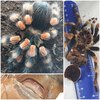Species Brachypelma smithi (a.k.a. Brachypelma annitha)
- Thread starter metallica
- Start date
- Joined
- Feb 27, 2011
- Messages
- 2,334
Oh, good! 'Cause I think a couple of B. annitha slings might want to come live at my house... Just saying.Thanks, yes I will.
tarantulagirl10
Arachnobaron
- Joined
- Oct 15, 2010
- Messages
- 537
Very nice!
- Joined
- Oct 13, 2011
- Messages
- 6,103
Very Impressive T & hope you get a egg sack
Yes I noticed it. His sack mate is a matured male and his carapace also lost the black patch. It seems as though it works the opposite with the females. Their carapace had only the black "V" patch on the carapace like the Brachypelma emelia as juveniles; but after they reached the four inch molt, the carapace became predominately black. I have four matured female Brachypelma smithi, and there are distinct color differences between the two species. The orange around the carapace and bands on the legs are more vibrant in the B. annitha. I have two unrelated female B. annitha; one is only four inches and the older female is several years older than her and the matured males. She is the one I bred.so the Mature Male loses the black patch on the carapace and the female maintains it?
Thanks for this!!! Nice user name, too!Yes I noticed it. His sack mate is a matured male and his carapace also lost the black patch. It seems as though it works the opposite with the females. Their carapace had only the black "V" patch on the carapace like the Brachypelma emelia as juveniles; but after they reached the four inch molt, the carapace became predominately black. I have four matured female Brachypelma smithi, and there are distinct color differences between the two species. The orange around the carapace and bands on the legs are more vibrant in the B. annitha. I have two unrelated female B. annitha; one is only four inches and the older female is several years older than her and the matured males. She is the one I bred.
Low
Arachnoknight
- Joined
- Sep 11, 2011
- Messages
- 221
Low
Arachnoknight
- Joined
- Sep 11, 2011
- Messages
- 221
Low
Arachnoknight
- Joined
- Sep 11, 2011
- Messages
- 221
Low
Arachnoknight
- Joined
- Sep 11, 2011
- Messages
- 221
Low
Arachnoknight
- Joined
- Sep 11, 2011
- Messages
- 221
Low
Arachnoknight
- Joined
- Sep 11, 2011
- Messages
- 221
Low
Arachnoknight
- Joined
- Sep 11, 2011
- Messages
- 221
- Joined
- Feb 27, 2011
- Messages
- 2,334
Beautiful! Do you have a male for her?
Toogledoo
Arachnoknight
- Joined
- Feb 3, 2011
- Messages
- 258
Nice, very pretty! 
Low
Arachnoknight
- Joined
- Sep 11, 2011
- Messages
- 221
Thank u, im very pleased with them myself.
Sent from my SAMSUNG-SGH-I897 using Tapatalk
Sent from my SAMSUNG-SGH-I897 using Tapatalk
Low
Arachnoknight
- Joined
- Sep 11, 2011
- Messages
- 221
Unfortunately no...but no big deal...shes only 4 inches, so shes got a few molts left before shes ready to pair.Beautiful! Do you have a male for her?
Sent from my SAMSUNG-SGH-I897 using Tapatalk
The Spider House
Arachnolord
- Joined
- Aug 12, 2020
- Messages
- 634





















